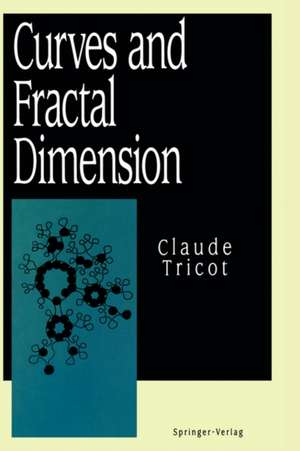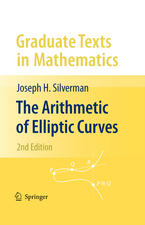Curves and Fractal Dimension
Cuvânt înainte de M. Mendes France Autor Claude Tricoten Limba Engleză Hardback – 17 noi 1994
| Toate formatele și edițiile | Preț | Express |
|---|---|---|
| Paperback (1) | 390.63 lei 43-57 zile | |
| Springer – 10 noi 2011 | 390.63 lei 43-57 zile | |
| Hardback (1) | 397.01 lei 43-57 zile | |
| Springer – 17 noi 1994 | 397.01 lei 43-57 zile |
Preț: 397.01 lei
Nou
Puncte Express: 596
Preț estimativ în valută:
75.99€ • 82.57$ • 63.87£
75.99€ • 82.57$ • 63.87£
Carte tipărită la comandă
Livrare economică 21 aprilie-05 mai
Preluare comenzi: 021 569.72.76
Specificații
ISBN-13: 9780387940953
ISBN-10: 0387940952
Pagini: 324
Ilustrații: XIV, 324 p.
Dimensiuni: 156 x 234 x 20 mm
Greutate: 0.63 kg
Ediția:1995
Editura: Springer
Colecția Springer
Locul publicării:New York, NY, United States
ISBN-10: 0387940952
Pagini: 324
Ilustrații: XIV, 324 p.
Dimensiuni: 156 x 234 x 20 mm
Greutate: 0.63 kg
Ediția:1995
Editura: Springer
Colecția Springer
Locul publicării:New York, NY, United States
Public țintă
Lower undergraduateDescriere
A mathematician, a real one, one for whom mathematical objects are abstract and exist only in his mind or in some remote Platonic universe, never "sees" a curve. A curve is infinitely narrow and invisible. Yet, we all have "seen" straight lines, circles, parabolas, etc. when many years ago (for some of us) we were taught elementary geometry at school. E. Mach wanted to suppress from physics everything that could not be perceived: physics and metaphysics must not exist together. Many a scientist was deeply influenced by his philosophy. In his book Claude Tricot tells us that a curve has a non-vanishing width. Its width is that of the pencil or of the pen on the paper, or of the chalk on the blackboard. The abstract curve which cannot be seen and which does not really concern us here is the intersection of all those thick curves that contain it. For Claude Tricot it is only the thick curves that are pertinent. He describes in detail the way bumps, peaks, and irregularities appear on the curve as its width decreases. This is not a new point of view. Indeed Hausdorff and Bouligand initiated the idea at the beginning of this century. However, Claude Tricot manages to refine the theory extensively and interestingly. His approach is both realistic and mathematically rigorous. Mathematicians who only feed on abstractions as well as engineers who tackle tangible problems will enjoy reading this book.
Cuprins
I. Sets of Null Measure on the Line.- 1. Perfect Sets and Their Measure.- 1.1 Duality set—measure.- 1.2 Closed sets and contiguous intervals.- 1.3 Perfect sets.- 1.4 Binary trees and the power of perfect sets.- 1.5 Symmetrical perfect sets.- 1.6 Tree representation of perfect sets.- 1.7 Bibliographical notes.- 2. Covers and Dimension.- 2.1 What is a null measure?.- 2.2 Hierarchy of sets of null measure.- 2.3 Cantor-Minkowski measure.- 2.4 Space filling and the order of growth.- 2.5 Orders of growth and dimension.- 2.6 Equivalent definitions of the dimension.- 2.7 Examples of computing the dimension.- 2.8 Some properties of the dimension.- 2.9 Upper and lower dimensions.- 2.10 Bibliographical notes.- 3. Contiguous Intervals and Dimension.- 3.1 Borel’s logarithmic rarefaction.- 3.2 Index of Besicovitch-Taylor.- 3.3 Equivalent orders of growth.- 3.4 The contiguous intervals and the fractal dimension.- 3.5 Algorithms to compute the dimension.- 3.6 Bibliographical notes.- II. Rectifiable Curves.- 4. What Is a Curve?.- 4.1 Some types of sets in the plane.- 4.2 Velocities, trajectories.- 4.3 The definition of a curve.- 4.4 Bibliographical notes.- 5. Polygonal Curves and Length.- 5.1 Rectifiability.- 5.2 Hausdorff distance.- 5.3 Polygonal approximations.- 5.4 The length of a curve.- 5.5 Two distinct notions.- 5.6 Measuring the length by compass.- 5.7 Bibliographical notes.- 6. Parameterized Curves, Support of a Measure.- 6.1 Parameterization by arc length.- 6.2 Image measure.- 6.3 Length by instantaneous velocity.- 6.4 The devil staircase.- 6.5 Length by the average of local velocity.- 6.6 Bibliographical notes.- 7. Local Geometry of Rectifiable Curves.- 7.1 Tangent, cone, convex hulls.- 7.2 Relations between local properties.- 7.3 Counterexamples.- 7.4 Tangent almost everywhere.- 7.5 Local length, almost everywhere.- 7.6 Rectifiability revisited.- 7.7 Bibliographical notes.- 8. Length, by Intersections with Straight Lines.- 8.1 Intersections, projections.- 8.2 The measure of families of straight lines.- 8.3 Family of lines intersecting a set.- 8.4 The case of convex sets.- 8.5 Length by secant lines.- 8.6 The length by projections.- 8.7 Application: practical computation of length.- 8.8 The length by random intersections.- 8.9 Buffon needle.- 8.10 Bibliographical notes.- 9. The Length by the Area of Centered Balls.- 9.1 Minkowski sausage.- 9.2 Length by the area of sausages.- 9.3 Convergence of the algorithm of the sausages.- 9.4 Reduction of balls to parallel segments.- 9.5 Bibliographical notes.- III. Nonrectifiable Curves.- 10. Curves of Infinite Length.- 10.1 What is infinite length?.- 10.2 Two examples.- 10.3 Dimension.- 10.4 Some examples of dimensions of curves.- 10.5 Classical covers: balls and boxes.- 10.6 Covers by figures of any kind.- 10.7 Covering curves by crosses.- 10.8 Bibliographical notes.- 11. Fractal Curves.- 11.1 What is a fractal curve?.- 11.2 A fractal curve is nowhere rectifiable.- 11.3 Diameter, size.- 11.4 Characterization of a fractal curve.- 12. Graphs of Nondifferentiable Functions.- 12.1 Curves parameterized by the abscissa.- 12.3 Size of local arcs.- 12.3 Variation of a function.- 12.4 Fractal dimension of a graph.- 12.5 Hölder exponent.- 12.6 Functions defined by series.- 12.7 Weierstrass function.- 12.8 Fractal dimension and the structure function.- 12.9 Functions constructed by diagonal affinities.- 12.10 Invariance under change of scale.- 12.11 The Weierstrass-Mandelbrot function.- 12.12 The spectrum of invariant functions.- 12.13 Computing the dimensions of the graphs.- 12.14 Bibliographical notes.- 13. Curves Constructed by Similarities.- 13.1 Similarities.- 13.2 Self-similar structure.- 13.3 Generator.- 13.4 Self-similar structure on [0,1].- 13.5 Parameterization of the generator.- 13.6 The limit curve ?.- 13.7 Simplicity criterion.- 13.8 Similarity and dimension exponent.- 13.9 Examples.- 13.10 The natural parameterization.- 13.11 The algorithm of local sizes.- 13.12 Bibliographical notes.- 14. Deviation, and Expansive Curves.- 14.1 Introducing new notions.- 14.2 Deviation of a set.- 14.3 Constant deviation along a curve.- 14.4 Definition of an expansive curve.- 14.5 Expansivity criterion.- 14.6 Expansivity and self-similarity.- 14.7 How to construct an expansive curve.- 14.8 Bibliographical notes.- 15. The Constant-Deviation Variable-Step Algorithm.- 15.1 A unified analysis of expansive curves.- 15.2 The covering index.- 15.3 Convex hulls and Minkowski sausages.- 15.4 A theorem on the dimension: the discrete form.- 15.5 Applications.- 15.6 Statistical self-similarity.- 15.7 Curves of uniform deviation.- 15.8 Applications.- 15.9 The dimension of a curve.- 15.10 Bibliographical notes.- 16. Scanning a Curve with Straight Lines.- 16.1 Directional dimension.- 16.2 Comparing the dimensions.- 16.3 Examples and applications.- 16.4 Coordinate systems.- 16.5 Intersections by straight lines.- 16.6 Essential upper bound.- 16.7 Uniform intersections.- 16.8 Intersection with an average curve.- 16.9 Bibliographical notes.- 17. Lateral Dimension of a Curve.- 17.1 Semisausages.- 17.2 Other expressions of the lateral dimensions.- 17.3 Possible values of the lateral dimension.- 17.4 Examples.- 17.5 The inverse Minkowski operation.- 17.6 Bibliographical notes.- 18. Dimensional Homogeneity.- 18.1 Local structures of some curves.- 18.2 Local dimension.- 18.3 The packing dimension.- 18.4 Possible values of the packing dimension.- 18.5 The ?-stabilization.- 18.6 Bibliographical notes.- IV. Annexes, References and Index.- A. Upper Limit and Lower Limit.- A.1 Convergence.- A.2 Nonconvergent sequences.- A.3 Nonconvergent functions.- A.5 Some applications.- B. Two Covering Lemmas.- B.1 Vitali’s lemma.- B.2 Covers by homothetic convex sets.- C. Convex Sets in the Plane.- C.1 Convexity.- C.2 Size of a convex set.- C.3 Breadth of a convex set.- C.4 Area of a convex set.- C.5 Convex hull.- C.6 Perimeter of the convex hull.- C.7 Area of the convex hull of a curve.- References.


















